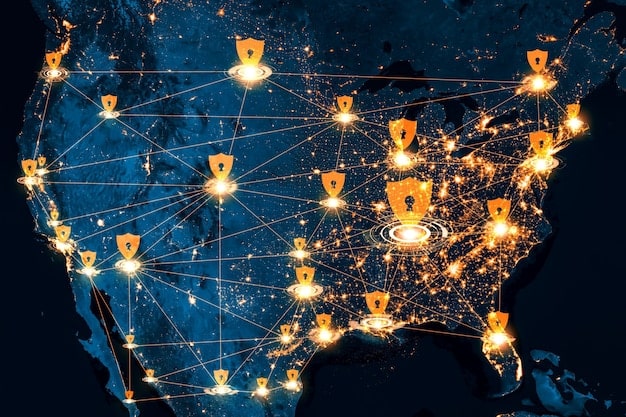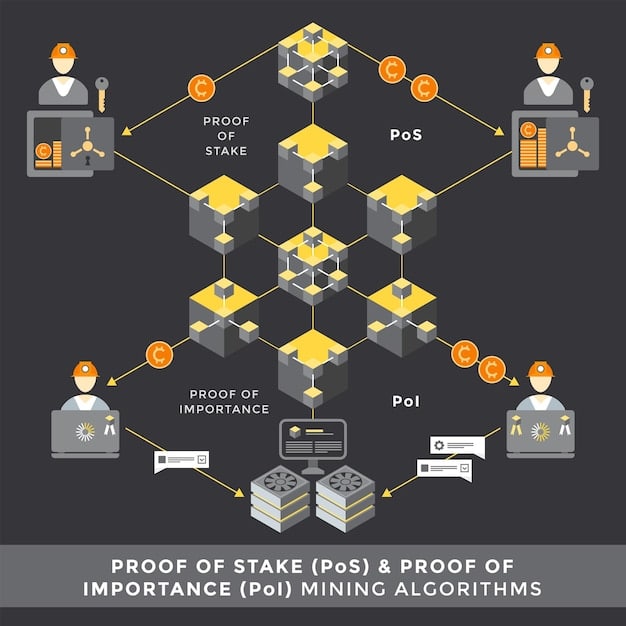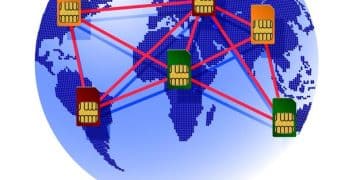Blockchain for US Supply Chains: Insider Insights & Potential

Insider knowledge reveals that blockchain technology offers unprecedented opportunities to transform US supply chain management through enhanced transparency, security, and efficiency, addressing key challenges in the industry.
Explore how blockchain technology is revolutionizing US supply chain management, offering insider insights into its potential to enhance efficiency, security, and transparency.
Understanding Blockchain’s Core Concepts
To grasp the potential of blockchain in reshaping US supply chains, it’s essential to understand the core concepts that underpin this revolutionary technology. Blockchain is more than just a buzzword; it’s a fundamental shift in how data is managed and secured.
What is Blockchain Technology?
At its heart, blockchain is a decentralized, distributed, and immutable ledger. This means that instead of a single entity controlling the data, it is spread across a network of computers. Each transaction or piece of information is recorded in a “block,” and these blocks are chained together chronologically, creating a permanent and transparent record.
Key Characteristics of Blockchain
Several key characteristics make blockchain particularly well-suited for supply chain management. Its transparency allows all participants in the chain to view the data, fostering trust and accountability. The immutability ensures that once a transaction is recorded, it cannot be altered or deleted, providing a secure and reliable audit trail. Decentralization reduces the risk of single points of failure and enhances resilience.

Think of blockchain as a shared digital record book that everyone in the supply chain can access. Every time a product changes hands or a process is completed, it’s recorded as a new entry in the record book. Because the record book is shared and secured by many computers, it’s very difficult to tamper with the records.
In summary, blockchain’s core concepts revolve around decentralization, transparency, and immutability, creating a secure and efficient framework for managing data across complex networks like supply chains.
Challenges Faced by US Supply Chains
US supply chains grapple with numerous challenges that hinder their efficiency, security, and resilience. These challenges range from a lack of transparency and traceability to risks associated with counterfeiting and fraud.
Lack of Transparency and Traceability
One of the most significant challenges is the lack of transparency and traceability in many supply chains. It can be difficult to track products from origin to the end consumer. This limited visibility can lead to inefficiencies, delays, and difficulties in pinpointing the source of problems, such as quality issues or ethical concerns.
Counterfeiting and Fraud Risks
Counterfeiting and fraud present substantial risks to US supply chains, especially in industries such as pharmaceuticals, electronics, and luxury goods. The inability to verify the authenticity of products can damage brand reputation, erode consumer trust, and result in significant financial losses. Traditional methods of tracking and verifying products are often vulnerable to manipulation and fraud.
Inefficiencies and Delays
Inefficiencies and delays plague many segments of US supply chains, increasing costs and reducing competitiveness. These issues can stem from various sources, including manual processes, data silos, and a lack of coordination among different parties involved in the supply chain.
These challenges highlight the need for innovative solutions that can enhance transparency, security, and efficiency in US supply chains. Blockchain technology emerges as a promising tool to address these pain points.
How Blockchain Can Transform US Supply Chains
Blockchain technology holds the key to transforming US supply chains by addressing the challenges of transparency, security, and efficiency. By providing a shared, immutable ledger, blockchain enables real-time tracking of products, reduces the risk of counterfeiting, and streamlines processes.
Enhanced Transparency and Traceability
Blockchain enhances transparency and traceability by providing a clear, auditable record of every transaction and movement of goods within the supply chain. Each product can be assigned a unique digital identity, allowing stakeholders to track its journey from origin to the end consumer. This level of visibility helps identify bottlenecks, prevent fraud, and ensure compliance with regulations.
Improved Security and Reduced Counterfeiting
The immutable nature of blockchain makes it an ideal tool for improving security and reducing counterfeiting. By recording product information on a blockchain, it becomes virtually impossible to alter or falsify data. This helps ensure the authenticity of products and reduces the risk of counterfeit goods entering the supply chain. In industries such as pharmaceuticals and luxury goods, where counterfeiting can have severe consequences, blockchain offers a powerful solution.
Streamlined Processes and Reduced Costs
Blockchain can streamline processes and reduce costs by automating tasks, eliminating intermediaries, and improving coordination among different parties involved in the supply chain. Smart contracts, self-executing agreements written into the blockchain, can automate processes such as payment settlements, customs clearance, and quality control. This reduces the need for manual intervention, minimizes errors, and accelerates transaction times.
- Real-Time Tracking: Provides instant visibility into product location and status
- Secure Data: Ensures data integrity and reduces the risk of tampering
- Automated Processes: Streamlines operations and reduces manual work
- Reduced Costs: Eliminates intermediaries and lowers transaction fees
Blockchain addresses the core challenges facing US supply chains, offering a pathway towards greater efficiency, security, and trust.

Real-World Examples of Blockchain in US Supply Chains
While the potential of blockchain in transforming US supply chains is clear, it’s equally important to examine real-world examples of companies that are already leveraging this technology to gain a competitive edge.
Walmart’s Food Traceability Initiative
Walmart, one of the world’s largest retailers, has implemented blockchain to improve food traceability. By tracking products such as mangoes and pork on a blockchain, Walmart has been able to reduce the time it takes to trace the origin of food products from days to seconds. This rapid traceability is crucial for identifying and containing foodborne illnesses, protecting consumers, and minimizing food waste.
IBM’s TradeLens Platform
IBM’s TradeLens platform is a blockchain-based solution designed to streamline global trade. It brings together multiple parties involved in the shipping process, including shipping companies, ports, customs authorities, and freight forwarders, to share data and collaborate more efficiently. TradeLens helps reduce delays, lower costs, and improve visibility across the supply chain.
Provenance’s Sustainable Supply Chains
Provenance is a company that uses blockchain to create more transparent and sustainable supply chains for various products, including fish, coffee, and textiles. By tracking products on a blockchain, Provenance enables consumers to verify the origin, authenticity, and ethical sourcing of the goods they purchase. This helps build trust and empowers consumers to make more informed purchasing decisions.
These real-world examples showcase the diverse applications of blockchain technology in US supply chains and demonstrate its potential to drive significant improvements in efficiency, security, and sustainability.
Overcoming Barriers to Blockchain Adoption
Despite the clear benefits of blockchain, its adoption in US supply chains is not without challenges. Several barriers can hinder the widespread implementation of this technology.
Lack of Standardization and Interoperability
One of the main barriers is the lack of standardization and interoperability among different blockchain platforms. Blockchain technology can lead to fragmentation and inefficiencies if different companies use incompatible systems. Efforts are underway to develop standards that will enable different blockchain platforms to communicate and share data seamlessly.
Regulatory Uncertainty
Regulatory uncertainty is another challenge. The legal and regulatory landscape surrounding blockchain is still evolving, and companies may be hesitant to invest in blockchain solutions without clear guidance from regulators. Governments and regulatory bodies are working to develop frameworks that will promote innovation while addressing potential risks associated with blockchain technology.
Scalability Concerns
Scalability concerns can also slow down blockchain adoption. Some blockchain platforms can struggle to handle large volumes of transactions, which is a crucial requirement for many US supply chains. Researchers and developers are exploring various solutions to improve the scalability of blockchain, including techniques such as sharding and layer-2 protocols.
- Collaboration: Encouraging industry-wide collaboration to establish common standards
- Regulatory Clarity: Advocating for clear and consistent regulations to provide certainty
- Technological Advancements: Supporting research and development efforts to improve scalability
Overcoming these barriers is essential to realizing the full potential of blockchain in transforming US supply chains.
The Future of Blockchain in US Supply Chains
Looking ahead, the future of blockchain technology in US supply chains is promising. As the technology matures, and adoption barriers are addressed, blockchain is poised to play an even more significant role in shaping the way goods are produced, distributed, and consumed.
Growing Adoption Across Industries
We can expect to see growing adoption of blockchain across various industries, from food and agriculture to pharmaceuticals and manufacturing. As more companies recognize the benefits of blockchain, they will increasingly invest in blockchain solutions to improve their supply chain operations.
Integration with Other Technologies
Blockchain will increasingly be integrated with other technologies, such as the Internet of Things (IoT), artificial intelligence (AI), and cloud computing. This integration will enable even more sophisticated and automated supply chain solutions. For example, IoT sensors can provide real-time data on product conditions, while AI can analyze blockchain data to optimize supply chain processes.
Focus on Sustainability and Ethical Sourcing
There will be a growing focus on using blockchain to promote sustainability and ethical sourcing in US supply chains. Consumers are increasingly demanding transparency and accountability from the brands they support, and blockchain can help companies demonstrate their commitment to responsible business practices.
The journey of blockchain in US supply chains is just beginning, and its impact will continue to grow as the technology evolves.
| Key Point | Brief Description |
|---|---|
| 🔑 Transparency | Blockchain enhances visibility across the supply chain. |
| 🛡️ Security | Immutable records reduce fraud and counterfeiting. |
| ⏱️ Efficiency | Automation streamlines processes and reduces costs. |
| 🌎 Sustainability | Supports ethical sourcing and sustainable practices. |
Frequently Asked Questions
▼
Blockchain is a decentralized, distributed ledger that records transactions across many computers. Each block contains a set of transactions, and once added to the chain, it cannot be altered, ensuring data integrity.
▼
Blockchain provides a clear, auditable record of every step in the supply chain. All participants can view the data, which enhances transparency and helps identify inefficiencies or potential issues quickly.
▼
The main benefits include enhanced transparency, improved security with reduced counterfeiting, streamlined processes that lower costs, and increased efficiency through real-time tracking and automation.
▼
Yes, challenges include a lack of standardization and interoperability among different blockchain platforms, regulatory uncertainty, and scalability concerns regarding handling large transaction volumes.
▼
Examples include Walmart’s food traceability initiative, which rapidly traces food origins, IBM’s TradeLens platform streamlining global trade, and Provenance’s use of blockchain for sustainable supply chains.
Conclusion
Blockchain presents a transformative opportunity for US supply chain management, offering solutions to enhance transparency, security, and efficiency. While challenges remain, the potential benefits are significant, paving the way for more resilient and sustainable supply chains. By embracing this technology, US businesses can unlock new levels of trust and performance in their operations.





